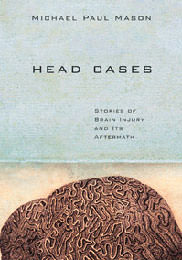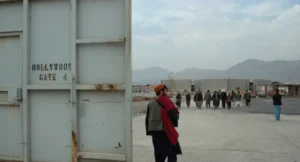Simon Lewis on Traumatic Brain Injuries
A devastating and growing problem is explored in Michael Paul Mason’s riveting new book, “Head Cases.”
Filmmakers often treat knocks on the brain as slapstick comedy, from Buster Keaton’s pratfalls to the Three Stooges’ choreographed head blows and, more recently, Ben Stiller’s parody of Simple Jack, the “retard,” in “Tropic Thunder.” Even kindly Charles Dodgson treats the Hatter at the Mad Tea Party of “Alice’s Adventures in Wonderland,” shifted in his consciousness because of mercury-induced lunacy, as a figure of fun. But one of that book’s disturbing insights is that, for a Hatter with dementia, time itself stands still.
In the real world, there’s no humor in insults to the brain. Chronic pain is a common complication, and tragedy often results from the suspension of time and consciousness in our skulls. Traumatic brain injury, or TBI, knows no rules, follows no timetable, recognizes no age or cultural boundaries, whether the victim is Muhammad Ali, Stephen King or someone you’ve never heard of. A brain injury strikes someone in America every 20 seconds, some million and a half times a year, from falls, car crashes or assaults, and at least 25,000 U.S. military members in Iraq and Afghanistan have suffered such injuries from explosions, shrapnel and other causes.
Whether a brain injury happens in a moment that goes unnoticed — perhaps an unfelt mosquito that vectors a neuropathogen into someone’s bloodstream — or is part of a catastrophic loss of consciousness, it challenges a soul from that moment forward, a life changed, perhaps into decades of psychosis and suffering that prove Gerard Manley Hopkins’ insight, “No worst, there is none.”
Head Cases: Stories of Brain Injury and Its Aftermath
By Michael Paul Mason
Farrar, Straus and Giroux, 320 pages
There are 5.3 million Americans living with disabilities from TBI, and it takes an average of $4 million, over a lifetime, to properly treat one.
To this biblical plague of mental, financial and societal devastation, Michael Paul Mason’s “Head Cases: Stories of Brain Injury and Its Aftermath” brings vital initiation, through his selection of 12 amazing patients; 12 apostolic accounts of lives of innocence uprooted by unimaginable experience, which Mason explores with awe, passion, humanity and skill. This elite case manager chooses perfectly from his Sisyphean caseload to show the myriad ways that brain trauma destroys lives: “ ‘I am a brain injury case manager,’ ” he tells the mother of a victim, “and there is the hint of a smirk because we both know that brain injuries cannot be managed any more than a thunderstorm can be managed. They can be endured, accepted, and integrated, but not managed.”
Mason is part spiritualist and part advocate, a care coordinator to those who, in an effort to avoid the typical aftermath of brain injury, seek out the hospital where he is based: “The sequence of events goes something like this: the brain gets damaged, and two months later, the million-dollar insurance policy is depleted and the patient is shuffled out the door with a shrug of shoulders. A course of treatment that should have lasted years is cut short before it even starts. …”
Mason describes men and women whose TBI has caused deficits across the range of human experience, and who show heroism in the truest sense: good people who face insurmountable odds. The most powerful accounts may bring tears, as when Mason evaluates an amnesiac suicide survivor, institutionalized for 16 months. A few well-chosen words reveal the patient as victim of brain injury and medical system alike: “If I were to take just one morning cycle of Daniel’s medication,” Mason notes, “it’s likely I wouldn’t wake up for days, possibly ever.”
In one of the book’s most unusual cases, Mason learns from his own patient when he enters a native American inipi, voyages into his own soul, and in the final round of the sweat tent, at somewhere near 200 degrees, gives up on his family, his home and all else: “I give up on this fucking job with all its fucked-up brains that must be saved and can’t be. I give up on healthcare reform, I give up on advocacy, I give up on hospitals and nursing homes and institutions and prisons. … I give up until there’s nothing left to give up.”
Therein lies the book’s main frustration. For readers in search of aid, it’s important to recognize that this book raises more questions than it answers; hints at available neuromodulation devices and neurorehabilitation programs. Given the importance of these devices and programs to countless survivors and their caretakers and families, and Mason’s great skills as storyteller and guide, it’s a lost opportunity to discover science-based diagnosis and treatments that work. Nonetheless, his great stories take readers through the elements of head injury diagnosis, from treatment protocols at Balad Hospital in Iraq (the literal front line of TBI treatment) to some of the facilities and resources in America. His cases range from an air traffic controller whose brain tells him that he is dead, to cases of seizures and rage attacks, to a man in prison for a crime he can’t remember because of a pathological injury to his brain.
Mason portrays vividly what lies ahead for them, and so many others: a desperate, tragic variation of the five stages of grief. But whereas acceptance is the normal final stage of grief, for anguish-stricken TBI victims acceptance means capitulation to the lifelong consequences of physical and emotional dependency, coupled with bankruptcy. Ultimately, the question of this book, the aftermath of TBI — and the potential for recovery of a damaged brain — remains one of science’s greatest puzzles.
From the book’s opening line — “The first thing I tell her is that I cannot help” — Mason gives the most limited answer: “I spend the last half hour of my evaluation explaining to Jake’s mother that this will take months at a minimum, but most likely a year or two — if anything happens at all.”
This mantra, that “you may or may not improve for the next two years,” is one this reviewer heard from doctors, many times over. Yet at the end of the book Mason recounts something quite inconsistent: “Marilyn takes me up to Spaulding Rehabilitation Hospital, where Debbie is currently receiving care. … More than thirty years after her injury, Debbie continues to make gains in her life, all because of the focus of one person, her mother.”
This is the knowledge gap which “Head Cases” leaves its readers. To address the paradox, Mason briefly references, as “mystery,” some new information: “In recent years neuroscience has revealed that the brain has a dynamic proclivity for self-recovery. In a global sense, the brain can actually relocate functions from one area of the brain to another. … The mystery of plasticity continues well into adulthood, allowing even elderly brains the capacity for restoration. Years after a brain injury occurs, adult survivors continue to make gains that surprise even the most optimistic doctors.”
It’s a shame that Mason doesn’t explore the treatments and hope derived from the medical fact that new neurons are created in the brain every day, even in people in their 70s, or mention to readers desperate for answers that neuroplasticity has been termed “one of the most extraordinary discoveries of the twentieth century.”
Head Cases: Stories of Brain Injury and Its Aftermath
By Michael Paul Mason
Farrar, Straus and Giroux, 320 pages
Similar to a book last year, “Train Your Mind, Change Your Brain: How a New Science Reveals Our Extraordinary Potential to Transform Ourselves,” which was Wall Street Journal science columnist Sharon Begley’s account of neuroplasticity, “Head Cases” offers few tips or guidance to this emerging paradigm shift in brain injury recovery.
“Head Cases” thus offers a schizophrenic approach to its central issue, the aftermath of brain trauma, in which at the book’s opening Mason gives his patient a time frame of one to two years, “if anything happens at all,” yet in the final pages describes an individual who, over 30 years after her TBI, continues to make gains.
Like the reader in search of knowledge, Mason lies awake in the dark beside his wife, ponders the mind’s mysteries as if the science of neuroplasticity still remains a complete unknown, and wonders “what it feels like to be waiting in between the world you left and the world you want.”
Perhaps it’s the mark of an important book that it leaves the reader hungry for more. Fascinated readers of “Head Cases” will finish the book eager for it.
Simon Lewis is a survivor of traumatic brain injury and is finishing “Rise and Shine: Finding the Hidden Path to Full Recovery,” his account of unexpected tragedy and regeneration. His Web site is http://simonlewis.us/.
Your support is crucial…With an uncertain future and a new administration casting doubt on press freedoms, the danger is clear: The truth is at risk.
Now is the time to give. Your tax-deductible support allows us to dig deeper, delivering fearless investigative reporting and analysis that exposes what’s really happening — without compromise.
Stand with our courageous journalists. Donate today to protect a free press, uphold democracy and unearth untold stories.







You need to be a supporter to comment.
There are currently no responses to this article.
Be the first to respond.